An investigation into the effects of group work in teaching speaking skills to ESP students at danang university of medical technology and pharmacy (DUMTP)
This study is attempted to determine the students’ passing ratio in English speaking skills
and explore the effects of group work in teaching English speaking skills to general nurse students at
DUMTP. 282 third-year students were selected to participate in the research. The collected data included
scores of the pre- and post-treatment of oral tests and information from the questionnaires. The result
showed little difference between pre- and post-test scores with the three teaching techniques: traditional,
group work and traditional and group work combined; however, the findings showed the students’
positive attitude towards group work in class. Hence, group work activities could have significant
pedagogical implications and could be a useful technique in a language classroom if they are carefully
planned.
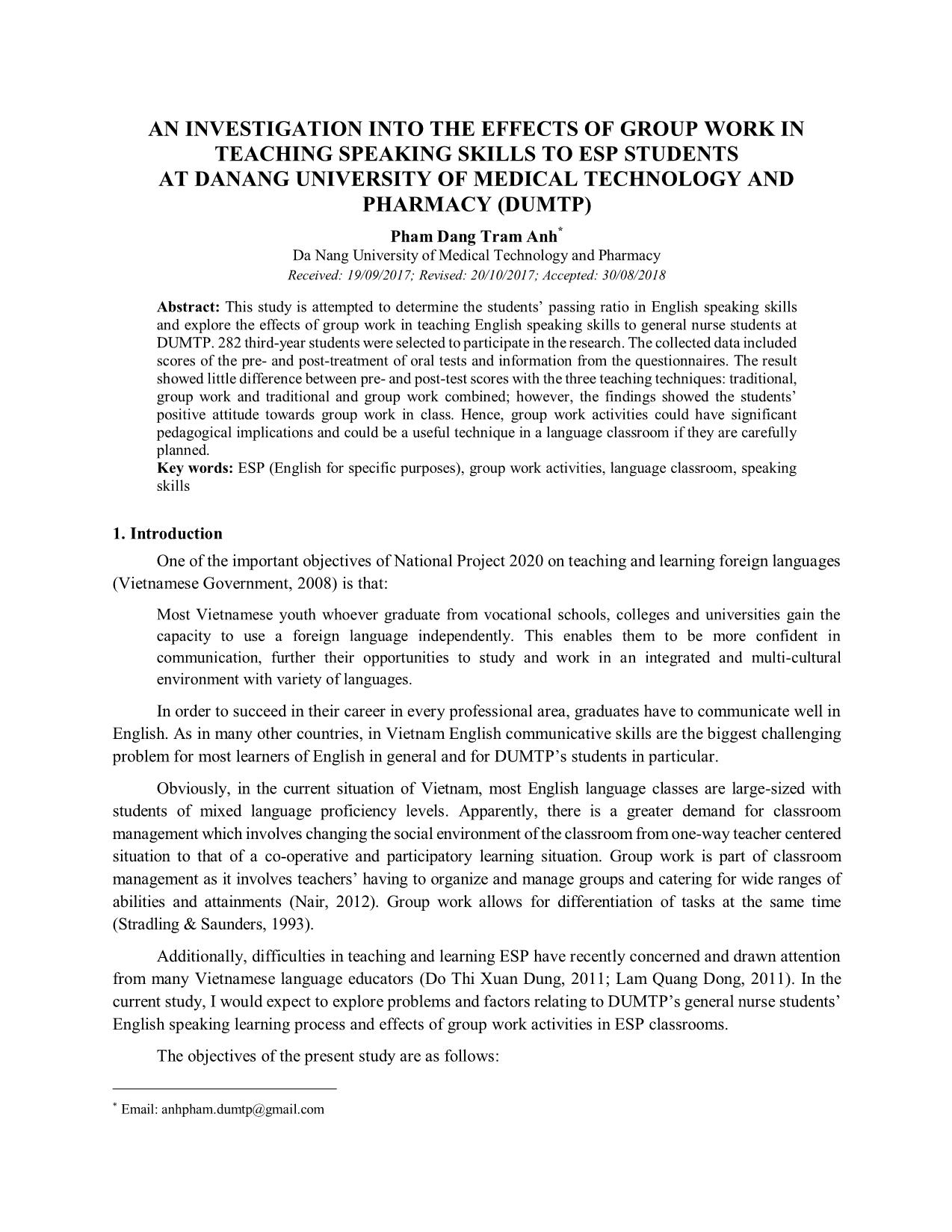
Trang 1
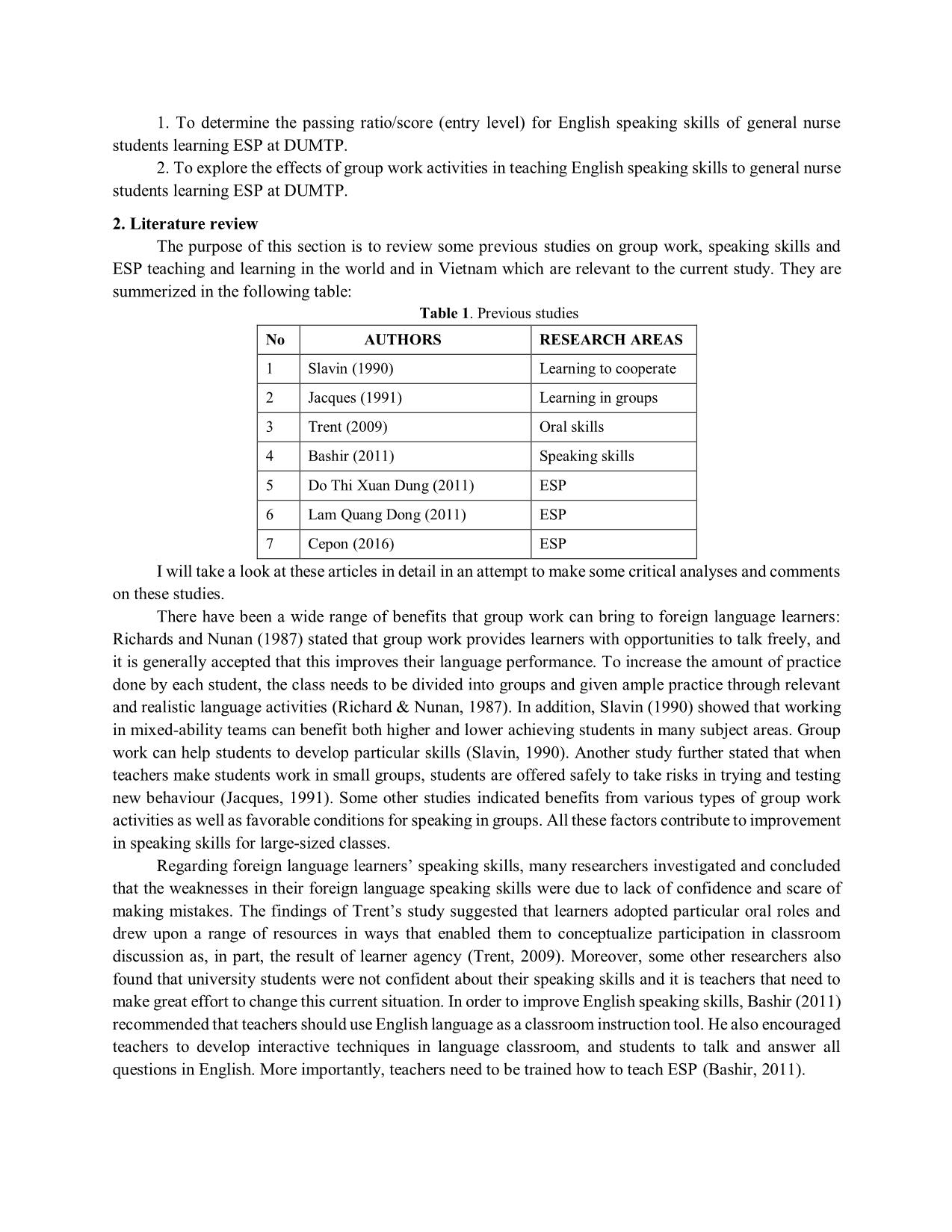
Trang 2
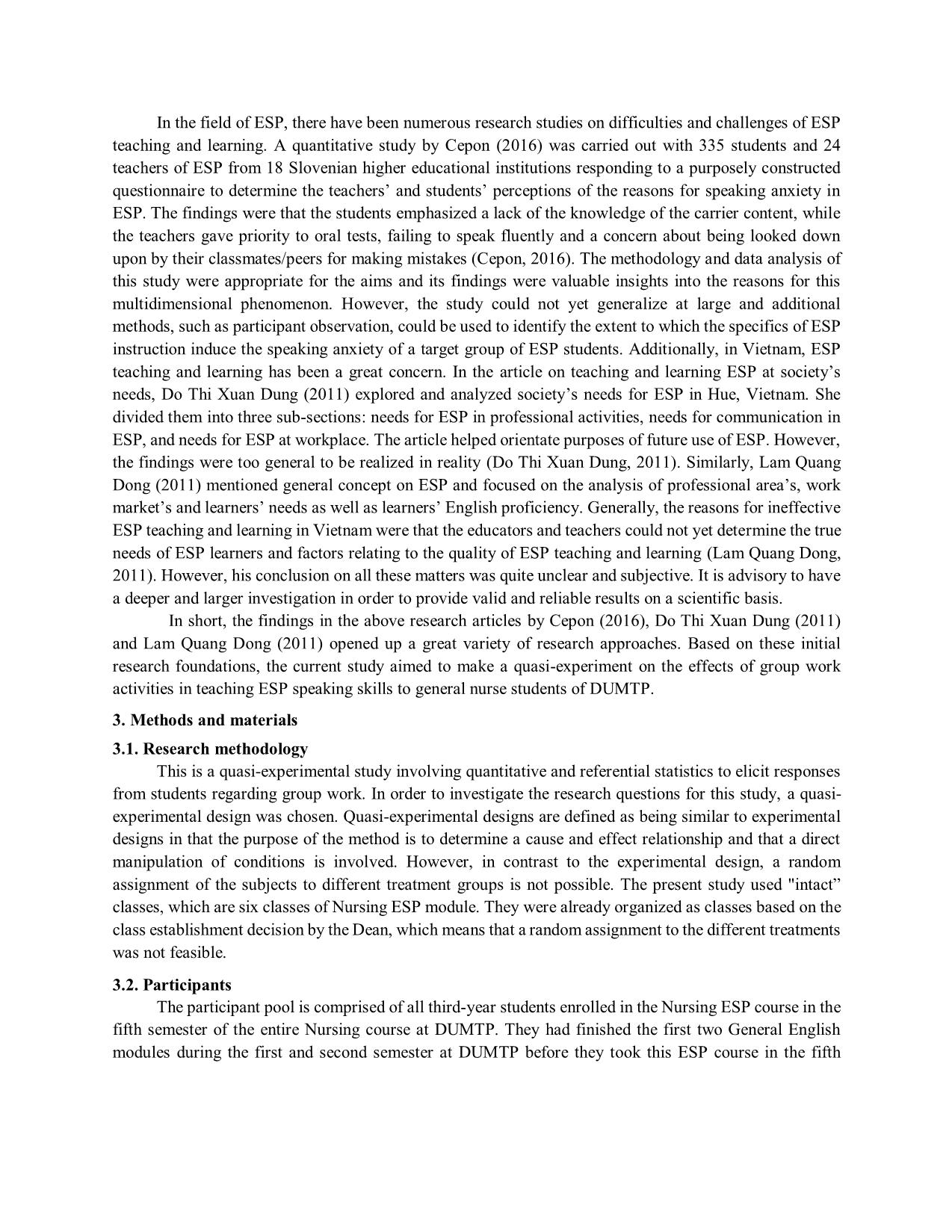
Trang 3
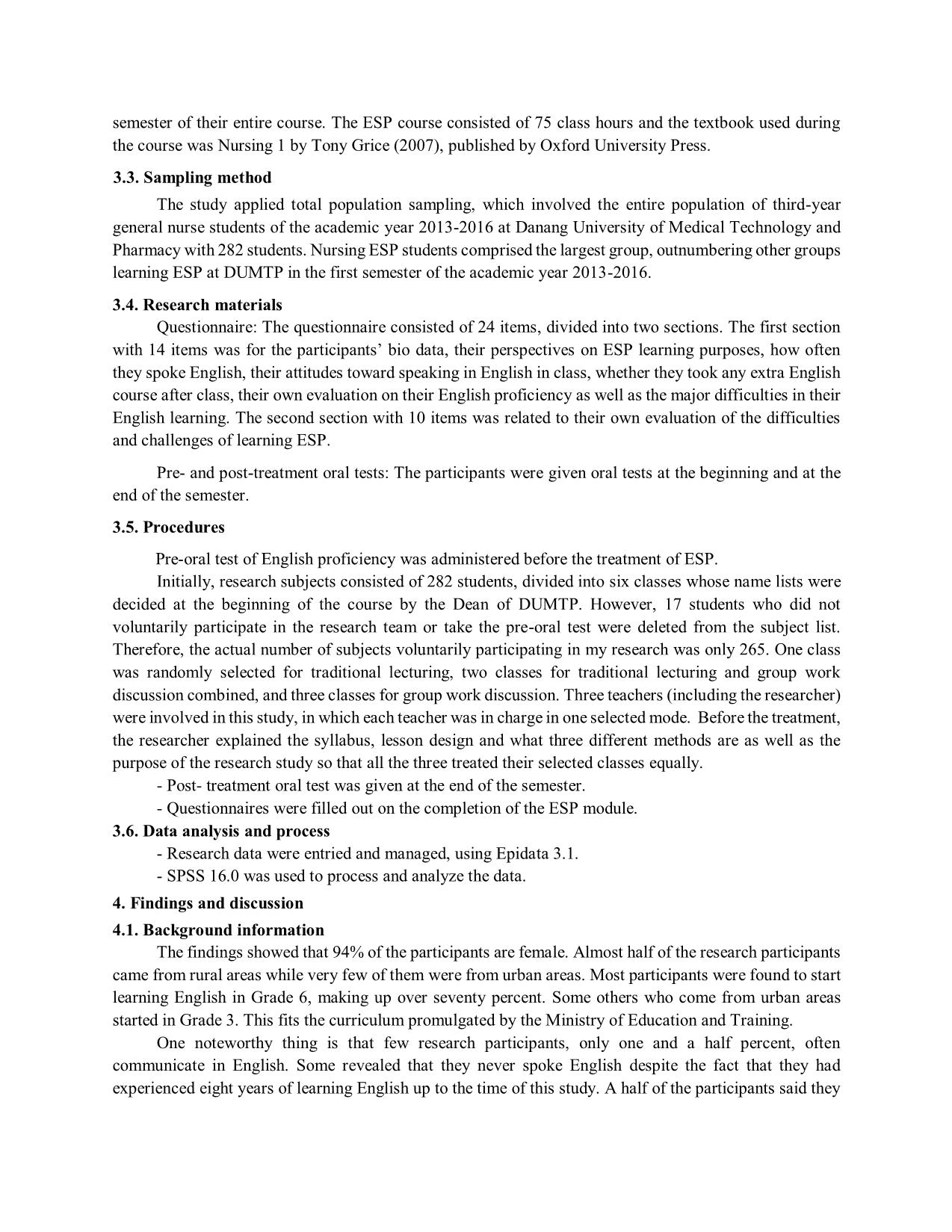
Trang 4
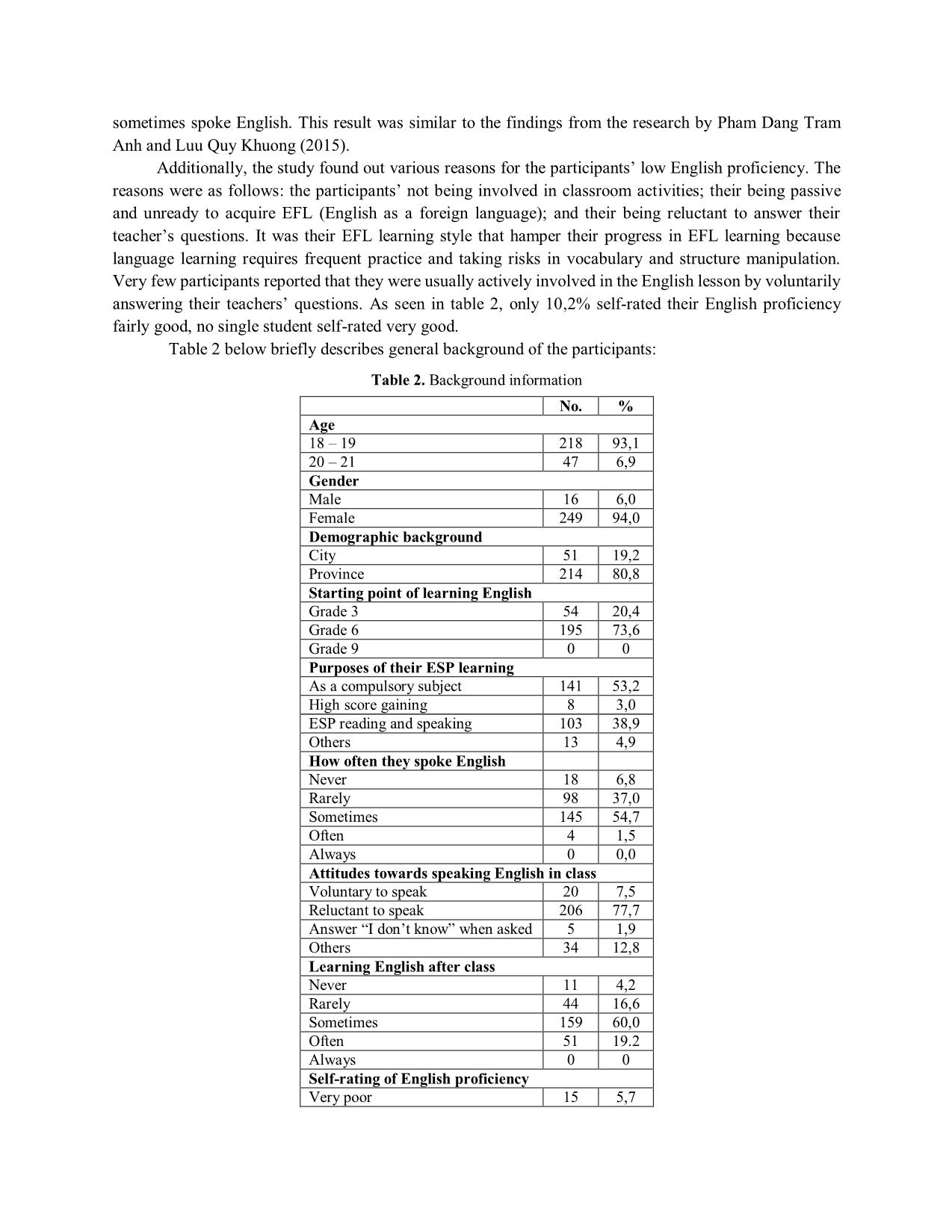
Trang 5
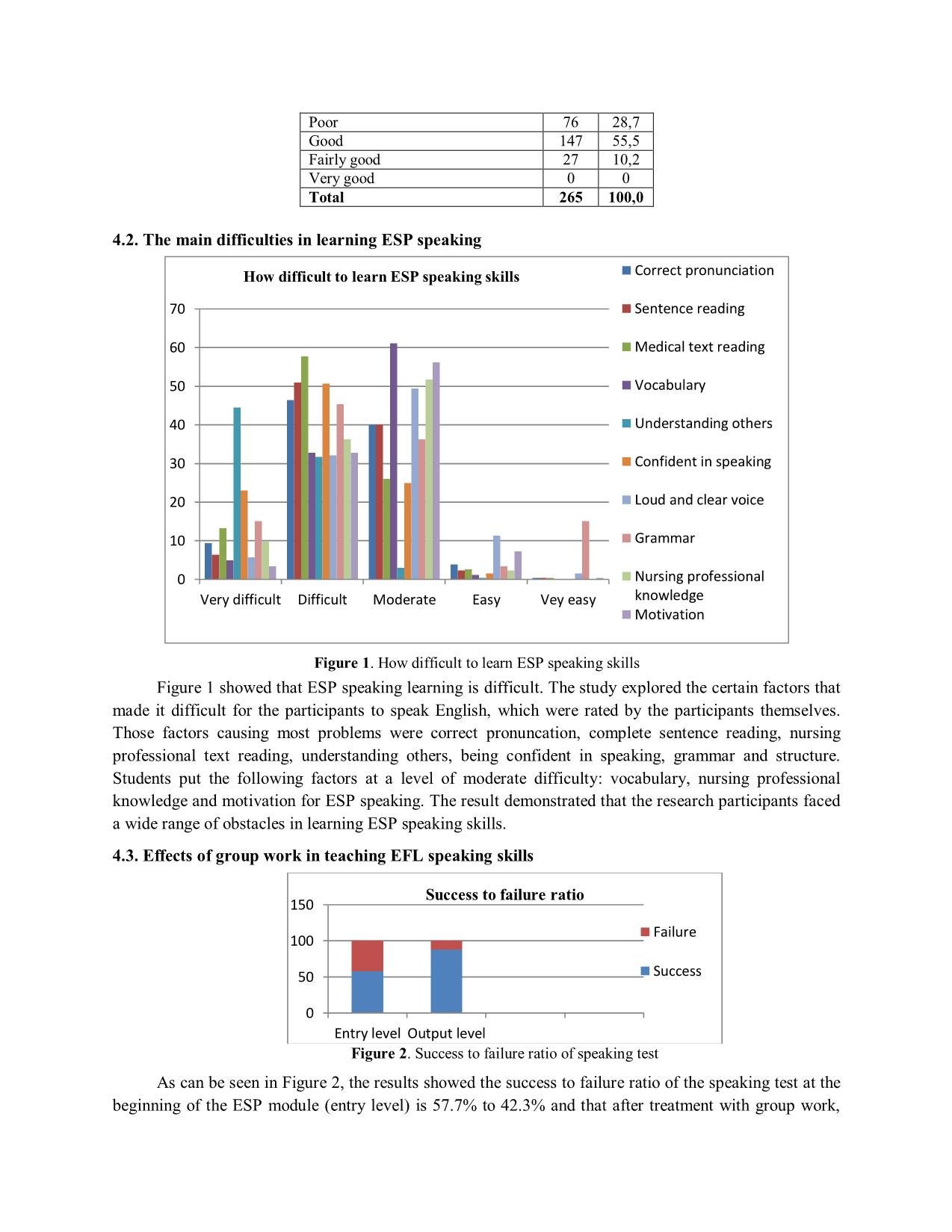
Trang 6
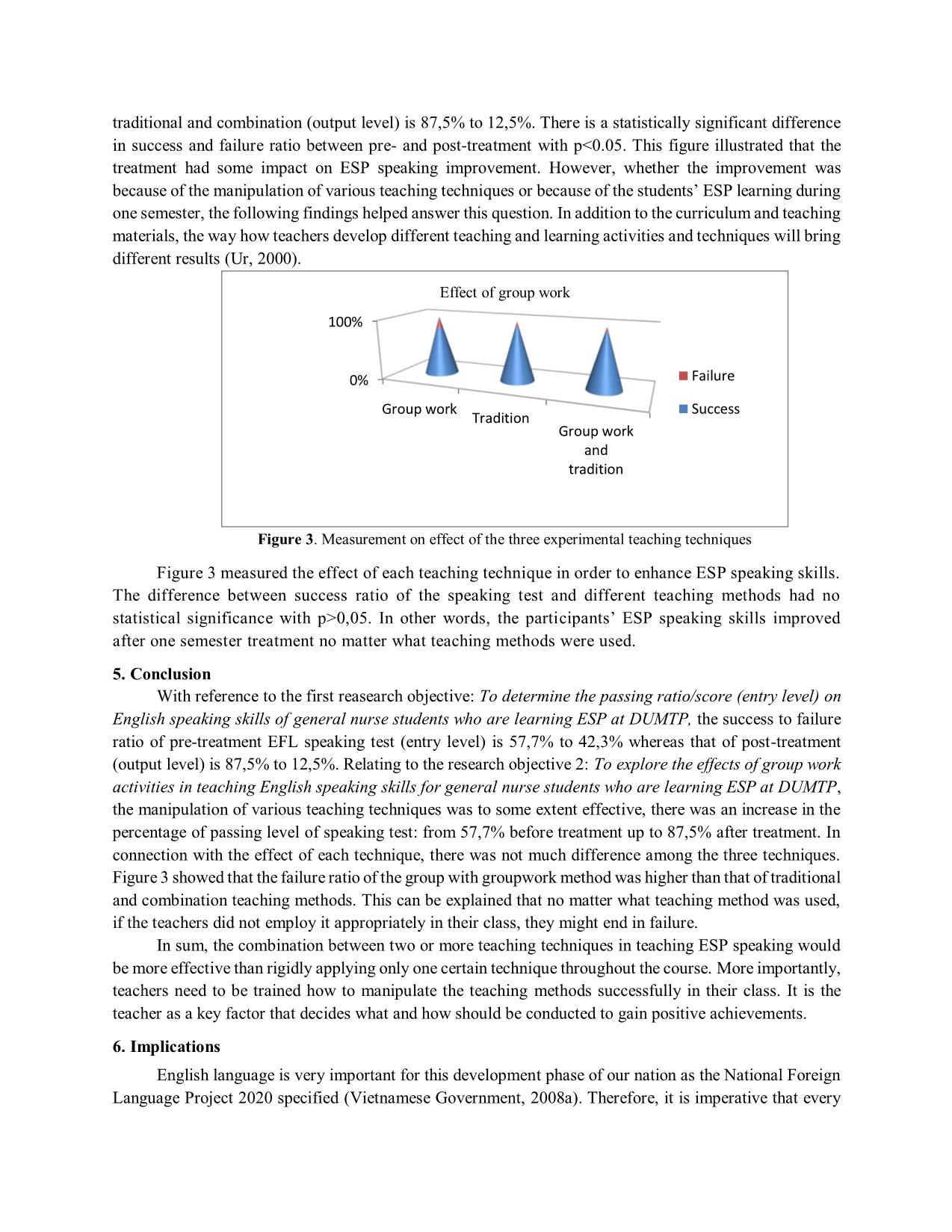
Trang 7
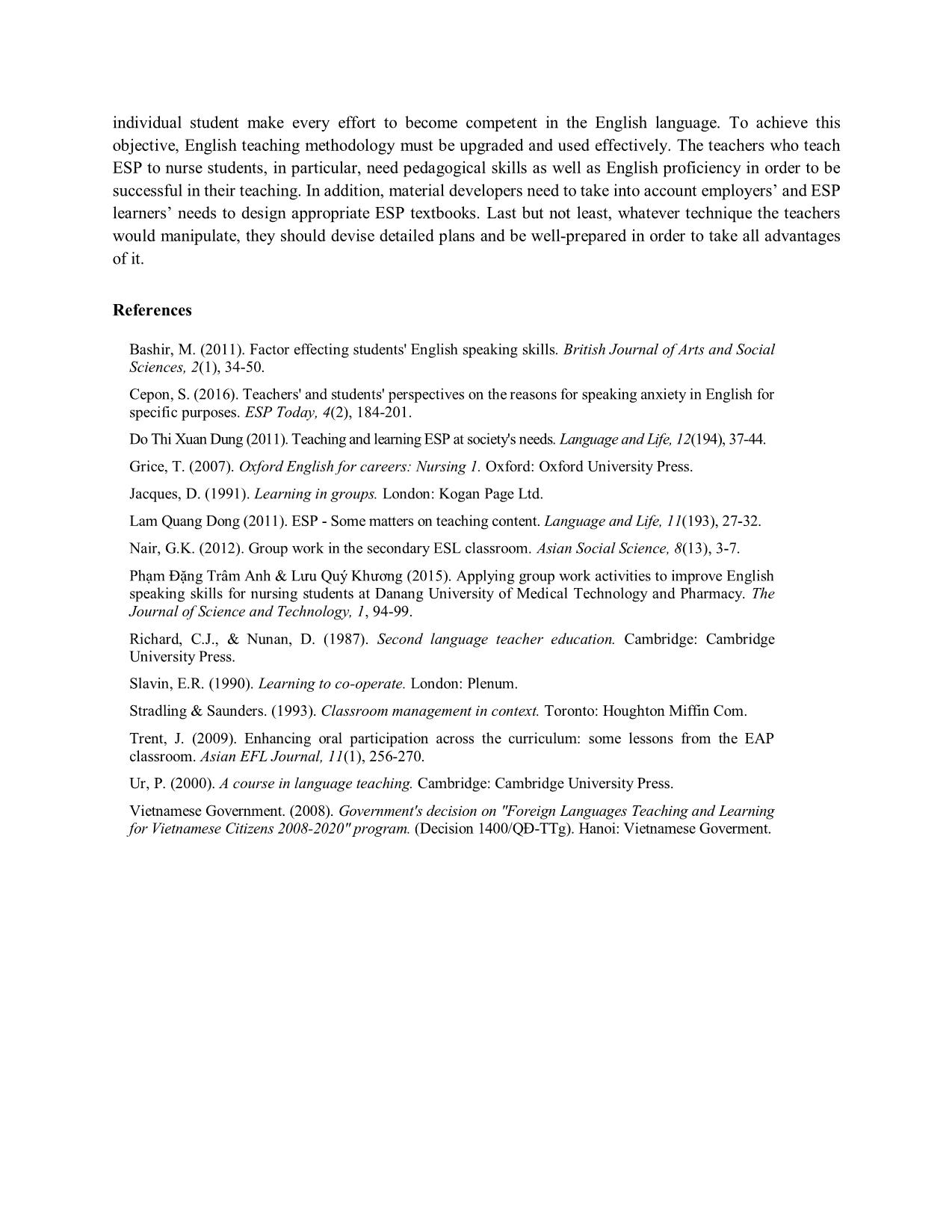
Trang 8
Tóm tắt nội dung tài liệu: An investigation into the effects of group work in teaching speaking skills to ESP students at danang university of medical technology and pharmacy (DUMTP)
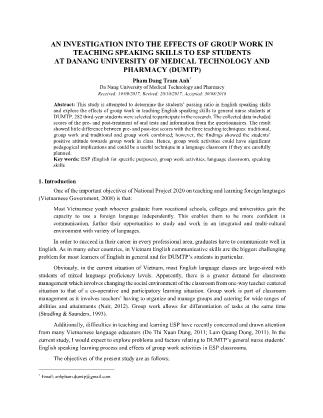
etnam. She divided them into three sub-sections: needs for ESP in professional activities, needs for communication in ESP, and needs for ESP at workplace. The article helped orientate purposes of future use of ESP. However, the findings were too general to be realized in reality (Do Thi Xuan Dung, 2011). Similarly, Lam Quang Dong (2011) mentioned general concept on ESP and focused on the analysis of professional area’s, work market’s and learners’ needs as well as learners’ English proficiency. Generally, the reasons for ineffective ESP teaching and learning in Vietnam were that the educators and teachers could not yet determine the true needs of ESP learners and factors relating to the quality of ESP teaching and learning (Lam Quang Dong, 2011). However, his conclusion on all these matters was quite unclear and subjective. It is advisory to have a deeper and larger investigation in order to provide valid and reliable results on a scientific basis. In short, the findings in the above research articles by Cepon (2016), Do Thi Xuan Dung (2011) and Lam Quang Dong (2011) opened up a great variety of research approaches. Based on these initial research foundations, the current study aimed to make a quasi-experiment on the effects of group work activities in teaching ESP speaking skills to general nurse students of DUMTP. 3. Methods and materials 3.1. Research methodology This is a quasi-experimental study involving quantitative and referential statistics to elicit responses from students regarding group work. In order to investigate the research questions for this study, a quasi- experimental design was chosen. Quasi-experimental designs are defined as being similar to experimental designs in that the purpose of the method is to determine a cause and effect relationship and that a direct manipulation of conditions is involved. However, in contrast to the experimental design, a random assignment of the subjects to different treatment groups is not possible. The present study used "intact” classes, which are six classes of Nursing ESP module. They were already organized as classes based on the class establishment decision by the Dean, which means that a random assignment to the different treatments was not feasible. 3.2. Participants The participant pool is comprised of all third-year students enrolled in the Nursing ESP course in the fifth semester of the entire Nursing course at DUMTP. They had finished the first two General English modules during the first and second semester at DUMTP before they took this ESP course in the fifth semester of their entire course. The ESP course consisted of 75 class hours and the textbook used during the course was Nursing 1 by Tony Grice (2007), published by Oxford University Press. ơ3.3. Sampling method The study applied total population sampling, which involved the entire population of third-year general nurse students of the academic year 2013-2016 at Danang University of Medical Technology and Pharmacy with 282 students. Nursing ESP students comprised the largest group, outnumbering other groups learning ESP at DUMTP in the first semester of the academic year 2013-2016. 3.4. Research materials Questionnaire: The questionnaire consisted of 24 items, divided into two sections. The first section with 14 items was for the participants’ bio data, their perspectives on ESP learning purposes, how often they spoke English, their attitudes toward speaking in English in class, whether they took any extra English course after class, their own evaluation on their English proficiency as well as the major difficulties in their English learning. The second section with 10 items was related to their own evaluation of the difficulties and challenges of learning ESP. Pre- and post-treatment oral tests: The participants were given oral tests at the beginning and at the end of the semester. 3.5. Procedures Pre-oral test of English proficiency was administered before the treatment of ESP. Initially, research subjects consisted of 282 students, divided into six classes whose name lists were decided at the beginning of the course by the Dean of DUMTP. However, 17 students who did not voluntarily participate in the research team or take the pre-oral test were deleted from the subject list. Therefore, the actual number of subjects voluntarily participating in my research was only 265. One class was randomly selected for traditional lecturing, two classes for traditional lecturing and group work discussion combined, and three classes for group work discussion. Three teachers (including the researcher) were involved in this study, in which each teacher was in charge in one selected mode. Before the treatment, the researcher explained the syllabus, lesson design and what three different methods are as well as the purpose of the research study so that all the three treated their selected classes equally. - Post- treatment oral test was given at the end of the semester. - Questionnaires were filled out on the completion of the ESP module. 3.6. Data analysis and process - Research data were entried and managed, using Epidata 3.1. - SPSS 16.0 was used to process and analyze the data. 4. Findings and discussion 4.1. Background information The findings showed that 94% of the participants are female. Almost half of the research participants came from rural areas while very few of them were from urban areas. Most participants were found to start learning English in Grade 6, making up over seventy percent. Some others who come from urban areas started in Grade 3. This fits the curriculum promulgated by the Ministry of Education and Training. One noteworthy thing is that few research participants, only one and a half percent, often communicate in English. Some revealed that they never spoke English despite the fact that they had experienced eight years of learning English up to the time of this study. A half of the participants said they sometimes spoke English. This result was similar to the findings from the research by Pham Dang Tram Anh and Luu Quy Khuong (2015). Additionally, the study found out various reasons for the participants’ low English proficiency. The reasons were as follows: the participants’ not being involved in classroom activities; their being passive and unready to acquire EFL (English as a foreign language); and their being reluctant to answer their teacher’s questions. It was their EFL learning style that hamper their progress in EFL learning because language learning requires frequent practice and taking risks in vocabulary and structure manipulation. Very few participants reported that they were usually actively involved in the English lesson by voluntarily answering their teachers’ questions. As seen in table 2, only 10,2% self-rated their English proficiency fairly good, no single student self-rated very good. Table 2 below briefly describes general background of the participants: Table 2. Background information No. % Age 18 – 19 218 93,1 20 – 21 47 6,9 Gender Male 16 6,0 Female 249 94,0 Demographic background City 51 19,2 Province 214 80,8 Starting point of learning English Grade 3 54 20,4 Grade 6 195 73,6 Grade 9 0 0 Purposes of their ESP learning As a compulsory subject 141 53,2 High score gaining 8 3,0 ESP reading and speaking 103 38,9 Others 13 4,9 How often they spoke English Never 18 6,8 Rarely 98 37,0 Sometimes 145 54,7 Often 4 1,5 Always 0 0,0 Attitudes towards speaking English in class Voluntary to speak 20 7,5 Reluctant to speak 206 77,7 Answer “I don’t know” when asked 5 1,9 Others 34 12,8 Learning English after class Never 11 4,2 Rarely 44 16,6 Sometimes 159 60,0 Often 51 19.2 Always 0 0 Self-rating of English proficiency Very poor 15 5,7 Poor 76 28,7 Good 147 55,5 Fairly good 27 10,2 Very good 0 0 Total 265 100,0 4.2. The main difficulties in learning ESP speaking Figure 1. How difficult to learn ESP speaking skills Figure 1 showed that ESP speaking learning is difficult. The study explored the certain factors that made it difficult for the participants to speak English, which were rated by the participants themselves. Those factors causing most problems were correct pronuncation, complete sentence reading, nursing professional text reading, understanding others, being confident in speaking, grammar and structure. Students put the following factors at a level of moderate difficulty: vocabulary, nursing professional knowledge and motivation for ESP speaking. The result demonstrated that the research participants faced a wide range of obstacles in learning ESP speaking skills. 4.3. Effects of group work in teaching EFL speaking skills Figure 2. Success to failure ratio of speaking test As can be seen in Figure 2, the results showed the success to failure ratio of the speaking test at the beginning of the ESP module (entry level) is 57.7% to 42.3% and that after treatment with group work, 0 10 20 30 40 50 60 70 Very difficult Difficult Moderate Easy Vey easy How difficult to learn ESP speaking skills Correct pronunciation Sentence reading Medical text reading Vocabulary Understanding others Confident in speaking Loud and clear voice Grammar Nursing professional knowledge Motivation 0 50 100 150 Entry level Output level Success to failure ratio Failure Success traditional and combination (output level) is 87,5% to 12,5%. There is a statistically significant difference in success and failure ratio between pre- and post-treatment with p<0.05. This figure illustrated that the treatment had some impact on ESP speaking improvement. However, whether the improvement was because of the manipulation of various teaching techniques or because of the students’ ESP learning during one semester, the following findings helped answer this question. In addition to the curriculum and teaching materials, the way how teachers develop different teaching and learning activities and techniques will bring different results (Ur, 2000). Figure 3. Measurement on effect of the three experimental teaching techniques Figure 3 measured the effect of each teaching technique in order to enhance ESP speaking skills. The difference between success ratio of the speaking test and different teaching methods had no statistical significance with p>0,05. In other words, the participants’ ESP speaking skills improved after one semester treatment no matter what teaching methods were used. 5. Conclusion With reference to the first reasearch objective: To determine the passing ratio/score (entry level) on English speaking skills of general nurse students who are learning ESP at DUMTP, the success to failure ratio of pre-treatment EFL speaking test (entry level) is 57,7% to 42,3% whereas that of post-treatment (output level) is 87,5% to 12,5%. Relating to the research objective 2: To explore the effects of group work activities in teaching English speaking skills for general nurse students who are learning ESP at DUMTP, the manipulation of various teaching techniques was to some extent effective, there was an increase in the percentage of passing level of speaking test: from 57,7% before treatment up to 87,5% after treatment. In connection with the effect of each technique, there was not much difference among the three techniques. Figure 3 showed that the failure ratio of the group with groupwork method was higher than that of traditional and combination teaching methods. This can be explained that no matter what teaching method was used, if the teachers did not employ it appropriately in their class, they might end in failure. In sum, the combination between two or more teaching techniques in teaching ESP speaking would be more effective than rigidly applying only one certain technique throughout the course. More importantly, teachers need to be trained how to manipulate the teaching methods successfully in their class. It is the teacher as a key factor that decides what and how should be conducted to gain positive achievements. 6. Implications English language is very important for this development phase of our nation as the National Foreign Language Project 2020 specified (Vietnamese Government, 2008a). Therefore, it is imperative that every 0% 100% Group work Tradition Group work and tradition Effect of group work Failure Success individual student make every effort to become competent in the English language. To achieve this objective, English teaching methodology must be upgraded and used effectively. The teachers who teach ESP to nurse students, in particular, need pedagogical skills as well as English proficiency in order to be successful in their teaching. In addition, material developers need to take into account employers’ and ESP learners’ needs to design appropriate ESP textbooks. Last but not least, whatever technique the teachers would manipulate, they should devise detailed plans and be well-prepared in order to take all advantages of it. References Bashir, M. (2011). Factor effecting students' English speaking skills. British Journal of Arts and Social Sciences, 2(1), 34-50. Cepon, S. (2016). Teachers' and students' perspectives on the reasons for speaking anxiety in English for specific purposes. ESP Today, 4(2), 184-201. Do Thi Xuan Dung (2011). Teaching and learning ESP at society's needs. Language and Life, 12(194), 37-44. Grice, T. (2007). Oxford English for careers: Nursing 1. Oxford: Oxford University Press. Jacques, D. (1991). Learning in groups. London: Kogan Page Ltd. Lam Quang Dong (2011). ESP - Some matters on teaching content. Language and Life, 11(193), 27-32. Nair, G.K. (2012). Group work in the secondary ESL classroom. Asian Social Science, 8(13), 3-7. Phạm Đặng Trâm Anh & Lưu Quý Khương (2015). Applying group work activities to improve English speaking skills for nursing students at Danang University of Medical Technology and Pharmacy. The Journal of Science and Technology, 1, 94-99. Richard, C.J., & Nunan, D. (1987). Second language teacher education. Cambridge: Cambridge University Press. Slavin, E.R. (1990). Learning to co-operate. London: Plenum. Stradling & Saunders. (1993). Classroom management in context. Toronto: Houghton Miffin Com. Trent, J. (2009). Enhancing oral participation across the curriculum: some lessons from the EAP classroom. Asian EFL Journal, 11(1), 256-270. Ur, P. (2000). A course in language teaching. Cambridge: Cambridge University Press. Vietnamese Government. (2008). Government's decision on "Foreign Languages Teaching and Learning for Vietnamese Citizens 2008-2020" program. (Decision 1400/QĐ-TTg). Hanoi: Vietnamese Goverment.
File đính kèm:
 an_investigation_into_the_effects_of_group_work_in_teaching.pdf
an_investigation_into_the_effects_of_group_work_in_teaching.pdf

